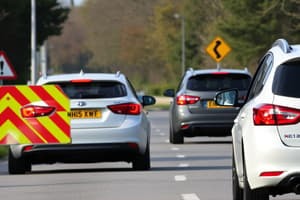Podcast
Questions and Answers
Which of the following are Major Traffic Violations? (Select all that apply)
Which of the following are Major Traffic Violations? (Select all that apply)
- Under Influence of Alcohol (.04) (correct)
- Following too closely
- Leaving Scene of Accident (correct)
- Fatality through Negligent Driving (correct)
A vehicle inspection during a trip is not necessary.
A vehicle inspection during a trip is not necessary.
False (B)
What is the penalty for a first conviction of a major traffic violation involving hazardous material?
What is the penalty for a first conviction of a major traffic violation involving hazardous material?
1 Year suspension
What are critical items to inspect during a vehicle inspection?
What are critical items to inspect during a vehicle inspection?
What should you do during Step 2: Engine Compartment inspection?
What should you do during Step 2: Engine Compartment inspection?
What is the maximum allowable tread depth for the front tires?
What is the maximum allowable tread depth for the front tires?
Which of the following is a Serious Traffic Violation? (Select all that apply)
Which of the following is a Serious Traffic Violation? (Select all that apply)
How often should the safety inspection be performed during a trip?
How often should the safety inspection be performed during a trip?
The penalty for a second conviction of a Major Traffic Violation is _____ years minimum.
The penalty for a second conviction of a Major Traffic Violation is _____ years minimum.
What is involved in Step 7: Hydraulic Leaks?
What is involved in Step 7: Hydraulic Leaks?
What must be included in the written report after each trip?
What must be included in the written report after each trip?
Flashcards are hidden until you start studying
Study Notes
Major Traffic Violations
- Under influence of alcohol (0.04) or refusing a test leads to penalties.
- Influence of controlled substances is a violation.
- Leaving the scene of an accident is prohibited.
- Negligent driving resulting in fatality is a serious offense.
- Operating while suspended incurs severe consequences.
- Drug smuggling carries significant legal penalties.
Conviction Times
- First conviction results in a one-year suspension; three years for hazardous materials.
- Two convictions lead to a minimum ten-year suspension.
- Negligent homicide or fleeing results in a one-year suspension.
- Drug smuggling can result in lifetime revocation of driving privileges.
Serious Traffic Violations
- Speeding over 15 MPH is classified as serious.
- Following too closely and erratic lane changes are violations.
- Any use of a cell phone while driving is prohibited.
- Traffic violations resulting in a fatal accident are grave.
- Reckless driving includes immediate consequences: two violations in three years lead to a 60-day suspension; three in the same timeframe lead to a 120-day suspension.
Railroad Violations
- Failing to stop at railroad crossings is a critical violation.
- Insufficient space to cross can result in penalties.
- Disobeying officers or devices at crossings incurs fines.
- Multiple offenses lead to increasing suspension periods (60 days for the first, up to one year for the third).
Vehicle Inspection (During Trip)
- Regular checks of gauges are essential.
- Utilize sensory observations (look, listen, smell, feel) to detect issues.
- Critical items to inspect: tires, brakes, lights, electrical connections, coupling devices, and cargo securement.
Vehicle Inspection (After Trip)
- Inspections after every trip are crucial.
- Check for proper tire pressure and tread depth.
- Inspect for cuts, damage, and potential tire separation.
- Ensure dual tires are in proper condition and not touching.
Continued Vehicle Inspection (Wheels and Rims)
- Check for damaged rims and rust around wheel nuts.
- Ensure no missing clamps, spacers, or studs.
- Look for any signs of welding repairs on wheels or rims.
Continued Vehicle Inspection (Brakes and Steering)
- Inspect brake drums for cracks and shoes for oil or grease.
- Ensure steering components are intact without missing parts.
- Check for excessive steering wheel play (over 10 degrees).
Continued Vehicle Inspection (Suspension System)
- Look for cracked or broken springs and leaking shock absorbers.
- Ensure all components are securely mounted without damage.
Continued Vehicle Inspection (Exhaust System)
- Check for loose or broken exhaust parts; ensure no leaks are present.
- Inspect for potential rubbing against other components.
Continued Vehicle Inspection (Emergency Equipment)
- Ensure fire extinguishers and warning devices are present and functional.
- Keep spare fuses and safety equipment secured in the vehicle.
Continued Vehicle Inspection (Cargo Trucks)
- Validate that the truck is not overloaded, and cargo is securely balanced.
7 Step Inspection Method (General)
- Consistency in performing inspections is crucial.
- Initial inspection should look for general vehicle condition and leaks.
- Hazard awareness around the vehicle is essential.
7 Step Inspection Method (Vehicle Overview)
- Daily written reports on vehicle condition are required.
- Motor carriers must ensure safety items are repaired as needed.
Step 2: Engine Compartment
- Check fluid levels (engine oil, coolant, power steering, etc.).
- Inspect for leaks and worn components.
Step 3: Starting Engine and Inspecting Cab
- Ensure parking brake is engaged before starting.
- Gauge readings should indicate normal operation levels after starting.
Step 3 Continued: Controls and Equipment
- Check all critical vehicle controls for proper operation and security.
Step 4: Checking Lights
- Turn on lights to verify proper operation before driving.
Step 5: Walk-around Inspection
- Inspect all aspects of the vehicle, including lights and visibility aids.
- Close and secure all compartments after inspection.
Step 6: Check Signal Lights
- Verify signal light operation from inside and outside the vehicle.
Step 7: Brake and Hydraulic Leaks
- Test system functionality by checking against the parking break.
Inspection During Trip
- Regularly check instrumentation and vehicle integrity throughout the journey.
Safety Inspection Requirements
- Conduct the first inspection within the first 50 miles; then every 150 miles or every three hours.
After Trip Inspection & Report
- Document vehicle condition after each trip and report any issues promptly.
Basic Controls
- Mastering vehicle control basics: accelerating, steering, stopping, and safe backing are essential for safe driving.
Studying That Suits You
Use AI to generate personalized quizzes and flashcards to suit your learning preferences.




